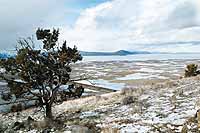Klamath low flow misses lake target
By DYLAN DARLING Freelance Writer
http://www.capitalpress.info/main.asp?FromHome=1&TypeID=1&ArticleID=8219&SectionID=67&SubSectionID=792
Capital Press Ag Weekly 3/8/04
 |
 |

Hanks Marsh lies partially
flooded along the east shore of
Upper Klamath Lake last week.
Despite recent storms, the lake
missed the end-of-month target
elevation set for protection of
endangered suckers by about 2 inches
Feb. 29. - Photo courtesy Gary Thain
|
 |
 |
KLAMATH FALLS, Ore. — Federal water
managers couldn’t deliver Feb. 29.
Upper Klamath Lake came up about 2
inches short of making end-of-the-month
elevations spelled out in a U.S. Fish
and Wildlife Service biological opinion
designed to protect two species of
lake-dwelling sucker fish.
Even though irrigation canals are shut
down for the winter, federal managers
can’t find enough water to meet minimum
flow requirements to protect threatened
coho salmon in the lower Klamath River
and minimum lake level requirements for
Upper Klamath Lake.
The U.S. Bureau of Reclamation, one of
three federal agencies involved in
balancing Klamath Basin water supplies,
was in talks much of last week with
USFWS, NOAA Fisheries and the Klamath
Tribes.
Adequate streamflows, apparently reduced
by a couple of dry years, just haven’t
materialized despite periodic winter
storms sweeping across the upper basin.
Upper Klamath Lake is the primary
storage for the BuRec Klamath Project,
and source of stored water NOAA
Fisheries requires for another
biological opinion protecting coho
salmon in the main Klamath River. Both
the suckers and coho are under
Endangered Species Act protection.
A recent spate of stormy weather boosted
inflow, but it wasn’t enough to push the
lake level to reach the designated
minimum elevation of 4,141.7 feet above
sea level.
Curt Mullis, manager of USFWS Klamath
Falls office, said the agency relaxed
the requirements for the end of February
because the recent cold snap that
dropped snow in the region is also
delaying the onset of sucker spawning.
Suckers usually start spawning in March.
Mullis said the long-lived sucker fish
shouldn’t be hampered by a shortened
spawning season.
“If we miss a little bit one year, it is
not as critical as with other fish,”
Mullis said.
Low flows downstream mean mandated
discharge at Iron Gate Dam, five miles
east of I-5 in far Northern California,
are below minimum discharge
requirements.
Since December, BuRec has been striking
agreements with the NOAA to decrease the
amount of water sent downstream.
BuRec Area Manager Dave Sabo said Iron
Gate flows for the first half of
February were about 1,300 cubic feet per
second, about 500 cfs below the
biological opinion’s requirement.
A blast of wet weather raised the flow
last week to about 2,200 cfs, but that
is expected to fall back to about 1,800
cfs soon, Sabo said.
Under the biological opinion, the river
is required to be at 2,100 cfs at the
start of March.
NOAA’s Jim Lecky said part of the
problem is how the biological opinions
are written, dividing water years by
annual expected flows. Current
operations are for a “below average”
year, which specify more water
downstream than in average or above
average years.
February flows, Lecky said, are
“probably higher” than needed for the
coho.
Sabo said last month BuRec intends to
renegotiate parts of both biological
opinions. NOAA is under court order to
revise the mainstem Klamath document.
But the court order didn’t cover
discharge or water year designations.
“It is a clear sign that these
biological opinions need to be reworked
to provide more flexibility for all of
us,” said Dan Keppen, executive director
of Klamath Water Users Association.
“Even without agriculture, sometimes
there is not enough water to meet both
needs.”
Requirements for protecting suckers and
salmon led to a nearly complete shutdown
of the Klamath Reclamation Project in
2001.
Bud Ullman, attorney for the Klamath
Tribes, said this winter’s flow problems
illustrate Klamath Basin troubles “even
in an average water year” because of
multiple commitments for the same water
resource.
|

